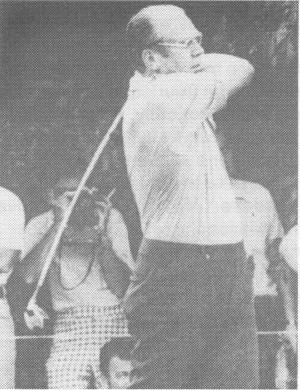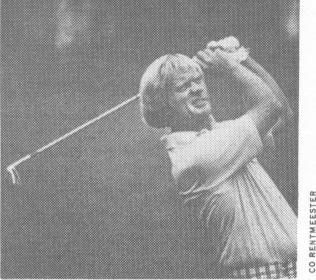| Previous | Index | Next |
![]()
Former President Gerald Ford maybe a 14handicap golf er, but Ariel found that his swing was as powerful as Jack Nicklaus'. Ford doesn't hit the ball as far, though, because his club isn't moving as quickly at the moment of impact.
shabby little storefront between
Eric's Giant Subs and Shumway's Paints on a quiet street in Amherst, Mass. Clarifying only slightly, a subhead on the sign explains, "Science serving industry, sports and human performance." "What Gideon has done," explains Dr. Conrad Wogrin, the matchmaker who brought Ariel and computers together 12 years ago at the University of Massachusetts, "is to treat the body much as an engineer would treat any kind of mechanism made up of links." Like a machine, the body requires that certain conditions be met if each part, each muscle is to carry out its function as well as humanly possible. As the seminal genius in his uncrowded field, the 40-year-old Ariel has been consulted on every form of human activity from the best way to strike a match to the most appropriate shape for a toilet seat. "Gideon will get an idea on Monday and his data by Friday," says his friend and business partner, tennis teacher Vic Braden, "while academia hasn't even scheduled its planning program."
Ariel subscribes to the theory that anything you can do, you can do better -even if you were pretty good to start with. When Mac Wilkins submitted to Arielization in 1975, he was already one of the best discus throwers in the world. Yet Gideon's computer printouts indicated that Wilkins' front leg was absorbing energy that could otherwise be utilized in his throw. Following Ariel's advice to alter his stride, Wilkins shattered the world record by nearly six feet, and went on to win the 1976 Olympic gold medal. The bad news for those who hope to challenge Wilkins in 1980 is that Ariel's computer says he is still throwing some 17 feet shy of his potential.
According to Gideon, biomechanics can be applied to anything that moves, human or otherwise. Several years ago three investors were debating which of five race horses to buy, and took their dilemma to Ariel. Gideon filmed each of the horses with a high-speed camera, and subjected the films to computer analysis. Printouts
in hand, he picked out a filly. "We determined that this horse's center of gravity didn't change as she ran, and therefore she was biomechanically the most efficient," says Ariel. The owners accepted his recommendation, and the horse won several races without a defeat.
Although the uses of biomechanics may be most obvious in the field of athletics, says Ariel, his science's application ranges into the arts. Several years ago, master violinist Paul Zukofsky made a pilgrimage to Gideon's Amherst headquarters. Ariel offered suggestions on stance and arm movement. "Now," he claims extravagantly, "Paul can play music that he has never played before." Zukofsky laughs off the notion that Gideon transformed him from a musical weakling to the Charles Atlas of stringed instruments, but believes that Ariel's work has great potential for aiding violin teachers. "With his help," he says, "we have been able to formulate a description of what a violin bow stroke is. Until recently we had been teaching our students, 'You do this because this is how you do it.'"
One of his primary goals, Ariel explains, is to take the guesswork out of coaching and other forms of instruction. "This office cannot coach athletes," he concedes, "but we can provide coaches with the tools to make the best athletes." When the Dallas Cowboys came to Ariel two years ago to find out how to prepare for the tug of war In ABC's Superteams competition, he told them the secret lay in harnessing the power of the legs.
"Coaches without this kind of information are like engineers without slide rules," he contends.
Rather than rely on a wish and a prayer, Ariel uses a camera that shoots up to 1,000 frames per second to analyze a blink-of-an-eye motion like Jimmy Connors' first serve. The film is then projected on a screen lined with 20,000 tiny directional microphones. Freezing the film, Ariel touches a point on the screen (Connors' elbow, for example) with a magnetically sensitive sonic pen. The coordinates of the point are fed into a computer, which then analyzes the physical components (velocity, acceleration, centers of gravity) involved at the instant the action was stopped. In Connors' case, Ariel found that the tennis ace's feet were leaving the ground at a crucial moment, diminishing the velocity of his serve by nearly 20 miles an hour. Connors recently began making adjustments, and his mother, Gloria, has written Gideon a letter of thanks.
A native Israeli, Ariel was devastated as a child by his parents' divorce. Afterward, at the age of 11, he was sent to a kibbutz by his father, an accountant, and his mother, who was secretary to the mayor of Tel Aviv. Ironically, physical education was Gideon's nemesis. "I was the slowest runner in the class," he recalls. "Even the girls beat me." Then, at 16, he encountered a teacher who fired him with purpose. "Somehow I related to this guy," he says, "and one day he gave me a book that showed how exercise could make your body look nice." From that
PEOPLE September 1979


![]()
| Previous | Index | Next |